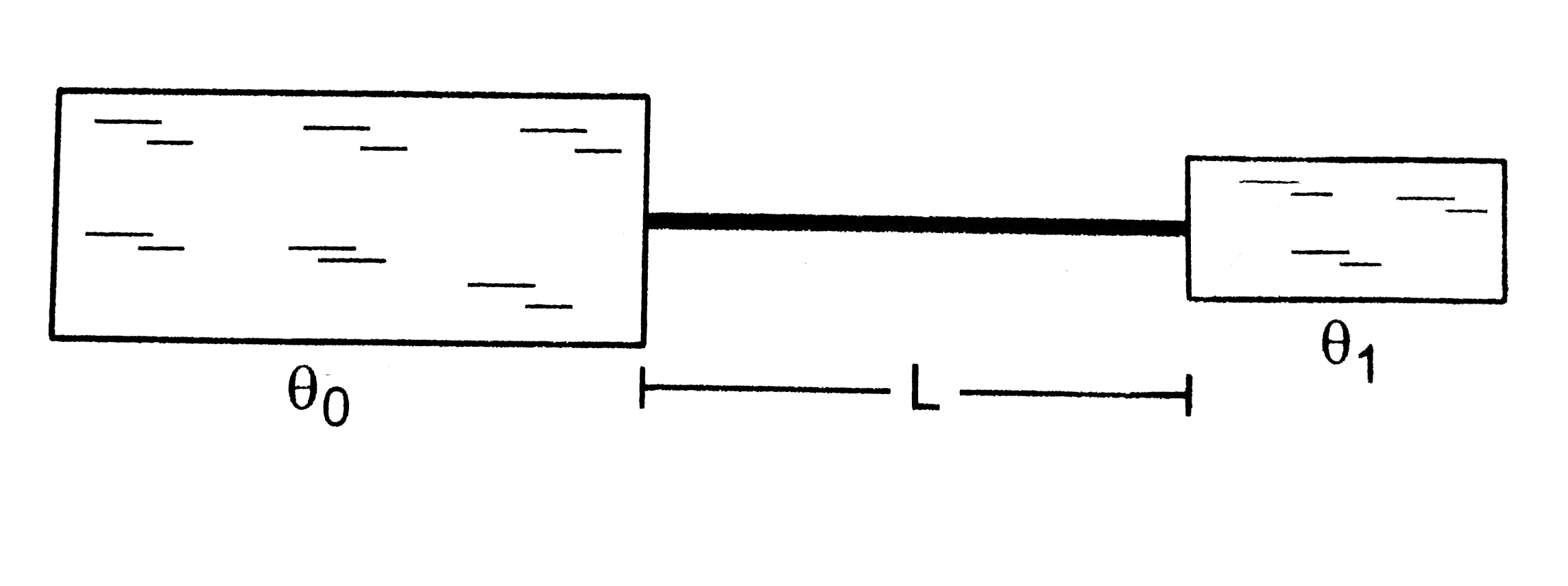Figure shows a large tank of water at a constant temperature θ0 and a small vessel containing a mass m of water at an initial temperature θ1(<θ0). A metal rod of length L, area of cross section A and thermal conductivity K connects the two vessels. Find the time taken for the temperature of the water in the smaller vessel to become θ2(θ1<θ2<θ0) . Specific heat capacity of water is s and all other heat capacities are negligible.
 Solution in Tamil
Solution in Tamil
Suppose, the temperature of the water in the smaller vessel is theta at time t. In the next time interval dt, a heat (DeltaQ) is transferred to it where
ΔQ=KAL(θ0−θ)dt . This heat increases the temperature of the water of mass m to θ+dθwhereDeltaQ=msd theta.From(i)and(ii),<br>KAL(θ0−θ)dt=msdθ . or, dt=LmsKAdθθ0−θ . or, ∫T0dt=LmsKA∫θ2θ1dθθ0−θ . where T is the time requierd for the temperature of the water to become θ2 . Thus, T=LmsKAln(theta_(0)-theta_(1))/(theta_(0)-theta_(2)) .
Topper's Solved these Questions
- HEAT TRANSFERBOOK - HC VERMACHAPTER - HEAT TRANSFEREXERCISE - QUESTIONS FOR SHORT ANSWER
11 Videos
- HEAT TRANSFERBOOK - HC VERMACHAPTER - HEAT TRANSFEREXERCISE - OBJECTIVE I
10 Videos
- HEAT TRANSFERBOOK - HC VERMACHAPTER - HEAT TRANSFEREXERCISE - EXERCIESE
55 Videos
- HEAT AND TEMPERATUREBOOK - HC VERMACHAPTER - HEAT AND TEMPERATUREEXERCISE - Exercise
34 Videos
- INTRODUCTION TO PHYSICSBOOK - HC VERMACHAPTER - INTRODUCTION TO PHYSICSEXERCISE - Exercises
19 Videos
Similar Questions
The heat current is written as ΔQΔt . Why don't we write dQdt ?
View SolutionThe thermal conductivity of a rod depends on
View SolutionA uniform slab of dimension 10cm×10cm×1cm is kept between two heat reservoir at temperatures 10∘C and 90∘C. The larger surface areas touch the reservoirs. The thermal conductivity of the material is 0.80Wm−1C−1 . Find the amount of heat flowing through the slab per minute.
View SolutionThe steam point and the ice point of a mercury thermometer are marked as 80∘C and 20∘C. What will be the temperature in centigrade mercury scale when this thermometer reads 32∘C?
View SolutionFind the dimensions of
a. linear momentum
b. frequency and
c. pressure
View SolutionIf (acosθ1,asinθ1),(acosθ2,asinθ2) and (acosθ3,asinθ3) represent the vertices of an equilateral triangle inscribed in a circle, then (a) cosθ1+cosθ2+cosθ3=0 (b) sinθ1+sinθ2+sinθ3=0 (c) tanθ1+tanθ2+tanθ3=0 (d) cotθ1+cotθ2+cotθ3=0
View Solutionif tan theta_(1)=k cot theta_(2) then find (cos(theta_(1)-theta_(2)))/(cos(theta_(1)+theta_(2)))=
View SolutionA body with an initial temperature θ1 is allowed to cool in a surrounding which is at a constant temperature of θ0(θ<θ1) Assume that Newton's law of cooling is obeyed Let k= constant The temperature of the body after time t is best experssed by .
View Solutionयदि sinθ1=35,tanθ2=12 तथा π2<θ1<π<θ2, तो सिद्ध कीजिए 8tanθ1−√5secθ2=−72
View SolutionIf cosθ1cosθ2+sinθ1sinθ2=cosθ0cosθ2+sinθ0sinθ2=1, where θ1 and θ0 do not differ by can even multiple of π, prove that
cosθ1⋅cosθ0cos2θ2+sinθ1⋅sinθ0sin2θ2=−1
View SolutionIf 0<θ2<θ1<π4,cos(θ1+θ2)=35 and cos(θ1−θ2)=45, then sinθ1sinθ2 equal to
View SolutionIf tanθ1.tanθ2=k, then: (cos(θ1−θ2)cos(θ1+θ2)=
View SolutionTwo different metal rods of the same length have their ends kept at the same temperature theta_(1) , and theta_(2) with theta_(2) gt theta_(1) . If A_(1) and A_(2) are their cross-sectional areas and K_(1) and K_(2) their thermal conductivities, the rate of flow of heat in the two rods will be the same it:
View SolutionFind |A| if A=[(0,cosθ1,sinθ1),(cosθ1,0,sinθ2),(sinθ1,−sinθ2,0)]
View SolutionA body with an initial temperature θ, is allowed to cool in a surrounding which is at a constant temperature of θ0(θ0<θi). Assume that Newton.s law of cooling is obeyed. Let k = constant. The temperature of the body after time t is best expressed by
View SolutionIf cos(θ1−θ2)cos(θ1+θ2)+cos(θ3+θ4)cos(θ3−θ4)=0 then
tanθ1.tanθ2.tanθ3.tanθ4=
View Solution
